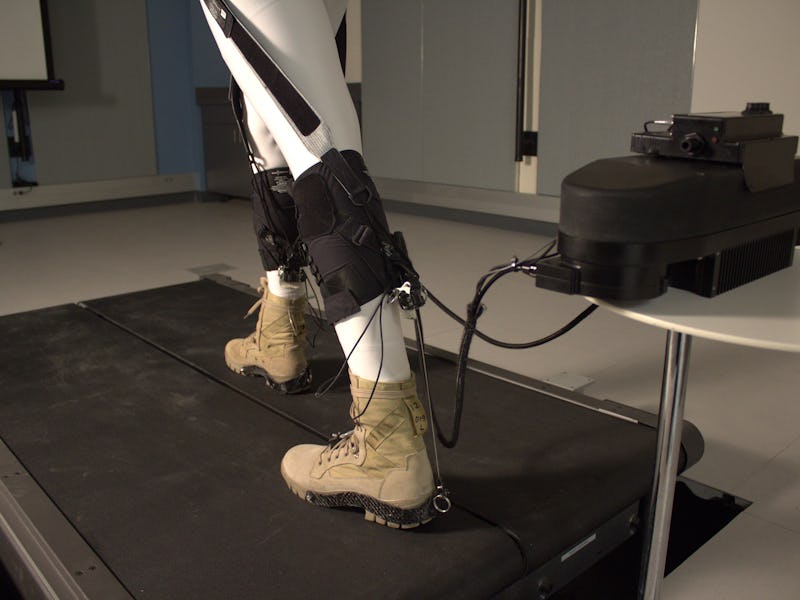The Hidden Exosuit Powers Mech March to Relevance
This is a future science fiction visionaries did not see coming.

For anyone born after the 1986 release of Aliens — and doubly for those who spent 1995 mesmerized by MechWarrior — the term “exosuit” calls to mind images of enormous, stompy robots with human operators perched in their bulging abdomens. But in the age of miniaturization, attempts to scale-up the human experience haven’t found much favor outside of science fiction. The idea of shrinking energy expenditure rather than equipment may change that. Researchers at Harvard University have created a soft exosuit the reduces the “metabolic cost of movement,” taking about a quarter of the effort out of walking. More brace than mech, the setup could represent the first step toward the popularization of a technology that has loitered at the fringes for decades.
The researchers believe the new exosuit will help able-bodied people with physically taxing jobs: firefighter, rescue worker, infantryman. The project was partially funded through DARPA’s Warrior Web program with its military application in mind (and presumably some regret about the failure of previous exo-efforts.) Taking the grunting out of being a grunt has long been a goal for military technologists. For civilians, it’s pressing workplace health issues more broadly.
“The vision is to wear the exosuit under normal clothing,” Harvard doctoral student Sangjun Lee explained in an email to Inverse. That means it could be a regular, integrated part of a uniform, or even slip on and off for a quick walk to the store and back. That’s something of a holy grail for first responders — and for people with disabilities that affect movement.
Diseases like Parkinson’s and cerebral palsy can make simple acts like walking up to 70 percent more metabolically expensive. Innovations like this one could help them perform tasks most people think of as easy without wiping themselves of energy for the rest of the day. Perhaps more importantly, an unobtrusive exosuit could do it without calling any more unwanted attention toward them. The rig will need more work to specialize it to the demands of each specific disability, but its basic design does help it to adapt to the needs of each particular user, on the fly.
The exosuit works with a network of elastic straps on the torso and lower body, and a single robotic actuator on the user’s ankle. This ankle unit applies varying levels of assistive force to help cushion and re-spring each step, pulling a simple array of bike brake cables in sync with the users walking rhythm. This rhythm is detected by a series of sensors on the limbs, which could one-day be sensitive enough to detect an aberrant gait and automatically offset it. Some of the ankle’s energy is also translated up, into the straps that help the larger, swinging leg movements that generally tire people out the most quickly.
Still, with such a potentially user-friendly form, it’s hard not to imagine the implications for society at large. The researchers think future soft exosuits like theirs could one day help the elderly with general daily fatigue, or let a hiker conquer a mountain with just the right amount of difficulty.
Predicted on the longer scale, one obvious possible application is physiotherapy, in which doctors or patients could set an exosuit to automatically ease the user back into the swing of unassisted movement as they recover from an injury. And who’s to say that in larger civilian life we would only ever want to make movement less difficult, not more?
Imagine if you could select a walking or running destination, a number of calories to burn, and then burn precisely that many calories on the run, as calibrated by your fitness exosuit. In one design, the maximum weight might be zero assistance, while another might be made so it can actually impede movement slightly, forcing the user to run through proverbial water.
This exosuit’s roughly 23 percent peak metabolic assistance in the lab builds off of an earlier model that offered just seven percent assistive force, in real-world conditions. While the team hopes to take this current model into the world for wider testing, they also note that their actuator maxed out its potential power without reaching a point of diminishing metabolic returns; that implies that a stronger actuator in their next test model could improve efficiency gains even further.
It turns out that exosuits have spectacular function, not spectacular form. It’s a miniaturization of vision that tailors a big idea to human scale.